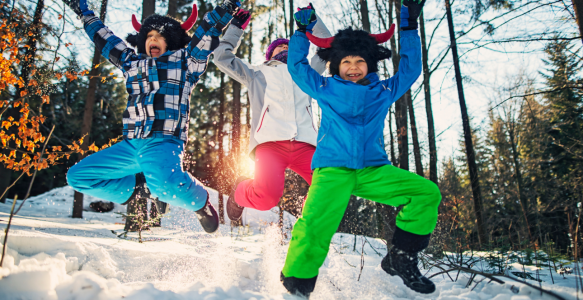Winter trekking is a thrilling and educational activity for school students, combining adventure with practical learning experiences. From exploring snow-laden trails to observing winter flora and fauna, trekking can enhance students’ physical fitness, teamwork, and environmental awareness. However, winter trekking also brings unique challenges and risks, such as slippery trails, harsh weather, and hypothermia. Ensuring student safety during winter treks requires meticulous planning, proper equipment, and a well-trained support team.
In this blog, we explore the essential safety tips every school should follow when organizing a winter trekking program, ensuring a fun yet secure adventure for students.
1. Pre-Trek Planning and Preparation
Safety starts long before the first step on the trail. Schools must prepare thoroughly to minimize risks:
a. Choosing the Right Trekking Location
- Select trails suitable for students’ age, fitness, and trekking experience.
- Avoid overly steep, icy, or avalanche-prone areas.
- Check local weather forecasts and trail conditions before confirming the trek.
b. Obtaining Permissions and Medical Clearance
- Secure permissions from parents or guardians, clearly explaining potential risks.
- Ensure students undergo a basic medical check-up to confirm they are fit for trekking.
c. Planning the Route and Emergency Stops
- Map out the trek route, including resting points, water sources, and emergency shelters.
- Share the route with local authorities and emergency services in advance.
2. Proper Clothing and Gear
Winter trekking demands specialized clothing and equipment to protect students from extreme cold, snow, and wind.
a. Layered Clothing System
- Base layer: Moisture-wicking thermal wear to keep sweat away from the skin.
- Insulating layer: Fleece or down jackets to retain body heat.
- Outer layer: Waterproof and windproof jackets and pants to shield against snow and wind.
b. Footwear and Accessories
- Waterproof trekking boots with good traction prevent slips and cold injuries.
- Wool or synthetic socks keep feet warm and dry.
- Gloves, hats, neck gaiters, and scarves protect extremities from frostbite.
c. Essential Trekking Gear
- Trekking poles for stability on slippery trails.
- Headlamps or flashlights with extra batteries for short daylight or unexpected delays.
- Backpacks with hydration packs, snacks, and emergency supplies.
3. Food, Hydration, and Nutrition
Cold weather increases the body’s energy requirements. Proper nutrition and hydration are critical:
- Pack high-energy snacks like nuts, chocolate, and energy bars.
- Encourage students to drink water regularly, even if they don’t feel thirsty.
- Avoid alcohol or caffeine, which can dehydrate the body in cold conditions.
4. Health and Safety Awareness
Educating students about winter-specific risks is vital:
a. Recognizing Hypothermia and Frostbite
- Hypothermia signs: Shivering, confusion, slurred speech, and fatigue.
- Frostbite signs: Numbness, pale or waxy skin, and tingling in fingers, toes, or ears.
- Take immediate action if symptoms appear: move to a warm area, remove wet clothing, and provide warm fluids.
b. Acclimatization
- Gradually expose students to higher altitudes to prevent altitude sickness.
- Limit initial trekking distance to help students adjust.
5. Group Management and Supervision
Proper supervision is key to maintaining safety in winter conditions:
- Maintain a consistent group size, with trained instructors leading and following the group.
- Use a buddy system to ensure no student is left behind or separated.
- Keep a manageable pace, allowing for rest and observation of students’ health.
6. Emergency Preparedness
Even with careful planning, emergencies can occur. Schools should be ready:
- Carry a well-stocked first-aid kit, including items for cold injuries, blisters, and minor cuts.
- Have a reliable communication plan: mobile phones, radios, or satellite phones if coverage is poor.
- Know the location of the nearest medical facility and have emergency evacuation procedures in place.
7. Navigating Winter Terrain
Snow, ice, and uneven trails increase the risk of slips and falls:
- Encourage students to walk carefully and maintain balance using trekking poles.
- Avoid walking on frozen streams, lakes, or steep icy slopes.
- Teach basic winter trekking skills, such as using crampons or microspikes if needed.
8. Environmental Awareness and Respect
Winter trekking is also an opportunity to teach students about nature conservation:
- Stay on designated trails to prevent soil erosion and protect fragile winter vegetation.
- Avoid disturbing wildlife and maintain a safe distance.
- Carry out all waste and avoid leaving behind any litter.
9. Post-Trek Care
Safety doesn’t end after reaching the base:
- Ensure students change out of wet clothing immediately to prevent hypothermia.
- Monitor students for delayed symptoms of cold-related conditions or fatigue.
- Conduct a debrief session to discuss experiences, safety observations, and lessons learned.
10. Tips for Schools Organizing Winter Treks
- Staff Training: Ensure teachers and guides are trained in winter survival, first aid, and emergency response.
- Communication Tools: Use walkie-talkies or GPS trackers to stay connected.
- Student Education: Conduct pre-trek workshops on cold-weather safety, trekking etiquette, and emergency procedures.
- Checklists: Prepare checklists for clothing, gear, food, and medical supplies to ensure nothing is overlooked.
Conclusion
Winter trekking can be an unforgettable experience for school students, offering physical challenges, environmental education, and team-building opportunities. However, the icy trails, unpredictable weather, and risk of cold-related injuries require meticulous planning and proactive safety measures. By following these winter trekking safety tips, schools can ensure that students enjoy a thrilling adventure while staying safe, warm, and healthy.
With proper preparation, guidance, and awareness, winter treks can be both educational and safe, leaving students with memories and skills that last a lifetime.


